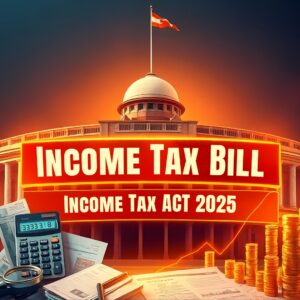
Income Tax Bill 2025: Key Highlights, Applicability & PDF
The long-awaited Income Tax Bill 2025 was finally presented in Parliament on February 13th. A dedicated committee has been formed to review the bill and submit its report by the first day of the Monsoon Session of Parliament. This article provides a detailed analysis of the Income Tax Bill 2025 details, including the proposed changes, their implications, and the objectives behind the new tax law.
Introduction to the Income Tax Bill 2025
The draft of the Income Tax Bill 2025 has been made available in the public domain, enabling taxpayers and professionals to understand its key provisions. Earlier speculations suggested that the new tax law would be renamed the Direct Tax Code. However, it has been officially confirmed that the new law will be known as the Income Tax Act 2025.
Get full Income Tax Bill 2025 PDF for a comprehensive look at the new provisions and changes in the tax law – Click here to Download
Effective Date of Implementation
A common question among taxpayers and students is the applicability date of the new law. The Income Tax Act 2025, will come into effect from April 1, 2026. This means that the first financial year to be taxed under the new Act will be FY 2026-27.
Guidance for Students Preparing for CA, CS & CMA Exams
Students preparing for taxation-related examinations should take note of the transition timeline:
- Exams conducted on or after April 1, 2027, will be based on the Income Tax Act 2025.
- Exams conducted until March 31, 2026, will follow the Income Tax Act, 1961.
Primary Objectives of the New Income Tax Bill 2025
The government aims to achieve three key objectives with the introduction of the New Income Tax Bill 2025 highlights:
- Modernization of India’s tax system to align with international best practices.
- Simplification of tax laws by using clearer language and reducing complexities.
- Streamlining tax calculations for individuals and businesses to ensure efficiency and transparency.
To meet these objectives, several structural changes have been introduced. Let’s explore these changes in detail.
Download the full Income Tax Bill 2025 PDF for a comprehensive look at the new provisions and changes in the tax law – Click Here
Key Highlights of the New Income Tax Bill 2025
The New Income Tax Bill 2025 introduces significant changes aimed at simplifying tax laws and improving efficiency. Key highlights include a streamlined structure, tax regime updates, and the inclusion of Virtual Digital Assets for taxation, which are:
1. Reduction in the Number of Sections
The old Income Tax Act had 298 sections; however, due to numerous sub-sections, the actual count exceeded 800 provisions. The new Income Tax Bill 2025 has streamlined the structure to 536 sections, eliminating redundant provisions.
2. Restructuring of Chapters
The previous Act contained 47 chapters, while the new Income Tax Bill PDF consolidates provisions into 23 chapters, making it more concise and organized.
3. Word Count Reduction
To enhance readability, the word count has been significantly reduced:
- Old Act: 5.12 lakh words
- New Income Tax Bill 2025: 2.6 lakh words
4. Reduction in Page Count
The new Income Tax Bill PDF consists of 622 pages, which is 200 pages less than the previous Act, making it easier to navigate.
5. Simplification of Language and Structure
To make the law more accessible, the government has introduced simpler language, tables, and formulas to clarify complex tax calculations.
6. Litigation Reduction Measures
A major goal of the Income Tax New Bill 2025 is to reduce litigation by incorporating past judicial pronouncements, ensuring more clarity and minimizing disputes between taxpayers and authorities.
7. Removal of the Concepts of Previous Year & Assessment Year
The traditional terms ‘Previous Year’ and ‘Assessment Year’ have been removed. Instead, the new Act introduces a single term, ‘Tax Year’, which will run from April 1 to March 31. The first tax year under this new system will be Tax Year 2026-27.
8. Continuation of Old and New Tax Regimes
Contrary to expectations, the old tax regime will continue alongside the Income Tax Act 2025. Many had anticipated its removal, but the government has opted to retain both options for taxpayers.
9. Inclusion of Virtual Digital Assets
The new Bill includes provisions for Virtual Digital Assets (VDA), such as cryptocurrencies and NFTs, classifying them as taxable assets. Previously, taxable assets primarily included money, bullion, and jewelry. The updated legislation ensures that undisclosed income in digital assets is also accounted for under the tax framework.
The complete Income Tax Bill 2025 PDF is available for download, providing in-depth insights into the updated tax framework – Get Now
10. Tax Slab Structure
The tax slab structure remains unchanged from what was announced in the Union Budget 2025. The effective tax on an income of INR 12 lakh will be NIL due to applicable rebates.
11. Retention of the Five Heads of Income
The fundamental structure of taxable income classification remains unchanged. The five heads of income continue to be:
- Salary
- House Property
- Business/Profession
- Capital Gains
- Other Sources
12. Changes in Section Numbers
To enhance the organization of tax laws, section numbers have been modified as follows:
- Salary Income: Old sections 15-17 are now 15-19.
- House Property Income: Old sections 20-27 are now 20-25.
- Business/Profession Income: Old sections 28-44 are now 26-66.
- Capital Gains: Old sections 45-55 are now 67-91.
- Other Sources: Old sections 56-59 are now 92-95.
While the number of sections has been reduced, the core provisions remain largely unchanged.
Conclusion
The Income Tax Bill 2025 marks a significant step towards modernizing India’s tax structure. By simplifying provisions, reducing litigation, and making the law more accessible, the new bill is expected to improve compliance and efficiency.
For those looking to study this bill in detail, the full Income Tax Act 2025 PDF version is available. Stay updated with the latest developments by following expert analyses and discussions on the topic.
We will continue to provide updates on any modifications or amendments to the Income Tax New Bill 2025.







